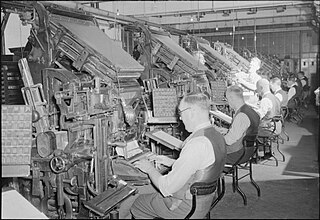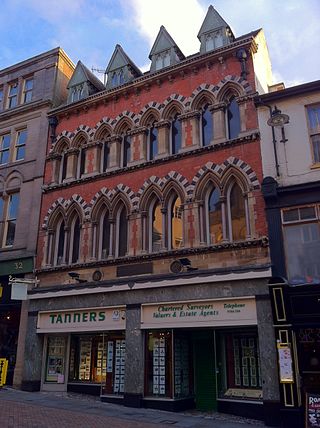

The Nottingham Daily Express was a local newspaper published in Nottingham between 1860 and 1918. It was a radical, Liberal and strongly Nonconformist newspaper. [1]


The Nottingham Daily Express was a local newspaper published in Nottingham between 1860 and 1918. It was a radical, Liberal and strongly Nonconformist newspaper. [1]
It was published from 4 January 1860 to 6 April 1918. It continued as the Nottingham Journal and Express 8 April 1918 – 5 September 1953 (incorporating the long dormant copyright of the Nottingham Journal which had been purchased from William Bradshaw in 1887). It was amalgamated with the Nottingham Guardian and subsequently published as the Guardian Journal. [2]
The Nottingham Daily Express was based in a building on Upper Parliament Street in Nottingham designed by the Nottingham-based architect Watson Fothergill. The ethos of the paper was marked by the inclusion over the door of images of the Liberal politicians Richard Cobden, William Gladstone and John Bright. With their prominence as leaders of the Anti-Corn Law League (1838–46) these were suitable subjects for the Liberal newspaper to commemorate. Inside the entrance are rows of tiles (originally on the Parliament Street front). The first row depicts Queen Victoria and Prince Albert, while the second row shows Lord Palmerston and Lord John Russell.
The building was completed in 1876 with three floors. In 1899 it was extended towards King Street and a fourth floor added.

The history of British newspapers dates to the 17th century with the emergence of regular publications covering news and gossip. The relaxation of government censorship in the late 17th century led to a rise in publications, which in turn led to an increase in regulation throughout the 18th century. The Times began publication in 1785 and became the leading newspaper of the early 19th century, before the lifting of taxes on newspapers and technological innovations led to a boom in newspaper publishing in the late 19th century. Mass education and increasing affluence led to new papers such as the Daily Mail emerging at the end of the 19th century, aimed at lower middle-class readers.

The Daily Express is a national daily United Kingdom middle-market newspaper printed in tabloid format. Published in London, it is the flagship of Express Newspapers, owned by publisher Reach plc. It was first published as a broadsheet in 1900 by Sir Arthur Pearson. Its sister paper, the Sunday Express, was launched in 1918. In June 2022, it had an average daily circulation of 201,608.

The Daily Record is a national tabloid based in Glasgow, Scotland. The newspaper is published Monday–Saturday and its website is updated on an hourly basis, seven days a week. The Record's sister title is the Sunday Mail. Both titles are owned by Reach plc and have a close kinship with the UK-wide Daily Mirror as a result.

The Scotsman is a Scottish compact newspaper and daily news website headquartered in Edinburgh. First established as a radical political paper in 1817, it began daily publication in 1855 and remained a broadsheet until August 2004. Its parent company, National World, also publishes the Edinburgh Evening News. It had an audited print circulation of 8,762 for July to December 2022. Its website, Scotsman.com, had an average of 138,000 unique visitors a day as of 2017. The title celebrated its bicentenary on 25 January 2017.

The Sun was a New York newspaper published from 1833 until 1950. It was considered a serious paper, like the city's two more successful broadsheets, The New York Times and the New York Herald Tribune. The Sun was the first successful penny daily newspaper in the United States and the first one to hire a Police reporter. It was also, for a time, the most successful newspaper in America.

Frederick William Pethick-Lawrence, 1st Baron Pethick-Lawrence, PC was a British Labour politician who, among other things, campaigned for women's suffrage.

Totnes is a parliamentary constituency in Devon represented in the House of Commons of the UK Parliament since December 2019 by Anthony Mangnall, a Conservative. Mangnall defeated incumbent Sarah Wollaston who had originally been elected as a Conservative but defected to the Liberal Democrats earlier that year.

Nottingham Victoria railway station was a Great Central Railway and Great Northern Railway railway station in Nottingham, England. It was designed by the architect Albert Edward Lambert, who also designed the rebuild of the Nottingham Midland station.

The University Pitt Club, popularly referred to as the Pitt Club, the UPC, or merely as Club, is a private members' club of the University of Cambridge, with a previously male-only membership but now open to both men and women.

Nottingham Council House is the city hall of Nottingham, England. The 200 feet (61 m) high dome that rises above the city is the centrepiece of the skyline and presides over the Old Market Square which is also referred to as the "City Centre". It is a Grade II* listed building.
The Nottingham Post is an English tabloid newspaper which serves Nottingham, Nottinghamshire and parts of Derbyshire, Leicestershire and Lincolnshire.
Hastings was a parliamentary constituency in Sussex. It returned two Members of Parliament to the House of Commons of the Parliament of the United Kingdom until the 1885 general election, when its representation was reduced to one member. It was abolished for the 1983 general election, when it was partially replaced by the new Hastings and Rye constituency.
Newcastle-upon-Tyne was a parliamentary borough in the county of Northumberland of the House of Commons of England from 1283 to 1706, then of the House of Commons of Great Britain from 1707 to 1800 and of the House of Commons of the United Kingdom from 1801 to 1918. It returned two Members of Parliament (MPs), elected by the bloc vote system.

Watson Fothergill was a British architect who designed over 100 unique buildings in Nottingham in the East Midlands of England, his influences were mainly from the Gothic Revival and Old English vernacular architecture styles.

Nottingham was a parliamentary borough in Nottinghamshire, which elected two Members of Parliament (MPs) to the House of Commons from 1295. In 1885 the constituency was abolished and the city of Nottingham divided into three single-member constituencies.
St Mark's Church, Nottingham, was a Church of England church in Nottingham, UK, between 1856 and 1958. The section of Huntingdon Street where the church was located was formerly called Windsor Street.

The Nottingham Journal was a newspaper published in Nottingham, Nottinghamshire, in the East Midlands in England. During that time, the paper went through several title changes through mergers, take-overs, acquisitions and ownership changes.

William Dymock Pratt was an architect based in Nottingham, England

William Beedham Starr JP was an architect based in Nottingham.

Herbert Vivian was an English journalist, author and newspaper owner, who befriended Lord Randolph Churchill, Charles Russell, Leopold Maxse and others in the 1880s. He campaigned for Irish Home Rule and was private secretary to Wilfrid Blunt, poet and writer, who stood in the 1888 Deptford by-election. Vivian's writings caused a rift between Oscar Wilde and James NcNeil Whistler. In the 1890s, Vivian was a leader of the Neo-Jacobite Revival, a monarchist movement keen to restore a Stuart to the British throne and replace the parliamentary system. Before the First World War he was friends with Winston Churchill and was the first journalist to interview him. Vivian lost as Liberal candidate for Deptford in 1906. As an extreme monarchist throughout his life, he became in the 1920s a supporter of fascism. His several books included the novel The Green Bay Tree with William Henry Wilkins. He was a noted Serbophile; his writings on the Balkans remain influential.